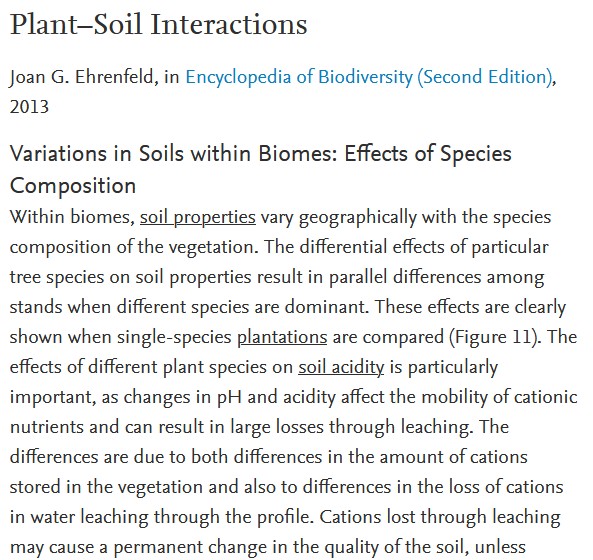
⛏ Digging Deep from the Field of Master Mind Agriculture (MMAGR) 🥕
Shared from the research of: Joseph Mercado 👦
Article Author: Joan G. Ehrenfeld – Encyclopedia of Biodiversity (Second Edition), 2013 👩
Content Contributor: Science Direct 🌏
To: Agricultural Lover 🚜
Blog Post #1212 📌
Re: Plant Soil Interactions 🪴
Date and Time: Monday, March 28, 2022 at 1:01 p.m. ⏰
Dear Agricultural Lover,
Variations in Soils within Biomes: Effects of Species Composition
Within biomes, soil properties vary geographically with the species composition of the vegetation.
The differential effects of particular tree species on soil properties result in parallel differences among stands when different species are dominant.
These effects are clearly shown when single-species plantations are compared (Figure 11).
The effects of different plant species on soil acidity is particularly important, as changes in pH and acidity affect the mobility of cationic nutrients and can result in large losses through leaching.
The differences are due to both differences in the amount of cations stored in the vegetation and also to differences in the loss of cations in water leaching through the profile.
Cations lost through leaching may cause a permanent change in the quality of the soil, unless weathering rates are equal to loss rates.
Successional changes in plant communities may in part be driven by plant-caused changes in soil structure and chemistry.
In many communities, high rates of nitrogen cycling (mineralization and nitrification) are observed early in succession, in association with herb or shrub-dominated communities, but these rates decrease markedly as trees come to dominate the community.
These decreases in nitrogen cycling rates are associated with changes in litter chemistry (more recalcitrant material, lower nutrient concentrations) and in root quantities and distributions.
A good example of this process is demonstrated by boreal ecosystems.
Early in succession, N-fixing alders (Alnus spp.) in shrubby communities support high rates of nitrogen mineralization and nitrification; these rates decline rapidly when the alders are replaced by poplars (Populus balsamifera) and white spruce (Picea glauca).
The decline in nitrogen cycling rates that accompanies the successional shift from alders to poplars is driven not only by differences in the N content of the litter, but also by the presence of high concentrations of tannins and phenolics in the spruce needles.
The tannins inhibit microbial activity, whereas the phenolic compounds are used as a carbon source by the microbiota; however, both compounds result in N immobilization.
Invasions of trees into grasslands are associated with a wide range of changes in soil properties.
For example, water content of the soils changes due to (a) differences in inputs (stem flow and drip from canopy leaves accentuate inputs, thick litter layers promote infiltration, but high rates of interception by the canopy can reduce total precipitation reaching the surface, and interception within the litter layer can prevent moisture from reaching mineral soil), (b) differences in soil porosity (large pores and channels associated with the growth of woody roots, and the growth of such roots to greater depths than the grasses), and (c) differences in loss (higher transpiration rates by trees, but shading decreases soil temperature and therefore evaporation rates, as does the accumulation of thick litter layers).
Large withdrawals of cationic nutrients occur, which are sequestered in the larger amounts of perennial biomass of woody plants.
Nitrogen becomes increasingly unavailable, as recalcitrant, lignin-rich litter accumulates. Finally, greater acidity of leaf litter tissue, greater production of organic acids from litter, and protons released through cation and ammonium uptake all drive acidification of the soil profile, with concomitant changes in both leaching loss of cations and weathering rates.
Just as changes in species composition may drive changes in soil properties, soil properties can affect successional patterns.
Fertile soils are thought to support faster rates of succession (i.e., rates of species replacement), but with lower plant diversity than infertile soils.
However, a wide variety of patterns have been observed, and many of the studies involve applications of nutrient fertilizer to experimental plots.
Additions of nutrients have promoted the growth of early successional annual species, or the persistence of perennial herbs at the expense of woody pioneers, but opposite results have also been observed.
Successional processes have also been related to the mechanism of competition among plant species for soil resources.
Tilman (1988) has shown that competitive ability is related to the capacity of a plant to obtain nutrients from the soil solution and thereby reduce concentrations below the minimum needed for competitors; this ability is balanced by the need to compete for light, so that the outcome of competition (and thereby the composition of a community) reflects the tradeoffs in competing for different resources.
Plant growing on infertile soils tend to have lower nutrient requirements (low uptake rates but compensating low growth rates) and higher rates of nutrient conservation (higher efficiency of nutrient use) compared to plants typically found in fertile soils.
The tradeoffs among characteristics promoting competitive success in infertile soils (strong competition for nutrients) versus success in fertile soils (competition for light being more important) ultimately determine the successional process in a given site.
Successional change can also be driven by negative plant–soil feedback resulting from the promotion of parasites and pathogens.
In grasslands, for example, it has been shown that early successional species can create dense populations of their soil-based enemies, resulting in a competitive advantage for later-successional species that are not affected by these populations of parasites and pathogens.
Changes in vegetation towards mid-successional stages of herbaceous plants result from this feedback.
However, it is not well known whether similar negative feedback processes operate with the woody species that make up later-successional stages.
Clearly, as soil properties themselves are dynamic, and change with changes in species composition, interplant interactions such as competition will change over successional time as the soil–plant system itself evolves.
Such a situation has been observed in the Netherlands, where high rates of atmospheric nitrogen deposition have driven a successional change from heath-dominated (Erica tetralix) communities to grass-dominated communities (Molinia caerula).
E. tetralis is characterized by low growth rates, low rates of biomass loss to shed tissues, herbivory, and so on, and poorly decomposable litter, which supports low rates of mineralization but high rates of sequestration in thick organic horizons.
In contrast, Molinia is characterized by high growth rates, high rates of tissue loss to shedding and herbivory, and rapidly decomposable litter. As expected, in experiments specifically testing competitive ability, Erica is a superior competitor when nutrient supplies are low, whereas Molinia is the superior competitor when nutrient supplies are high.
Thus, the feedback relationships between plants and soils can drive successional changes in community composition.
Content Source: Science Direct

 Email Us a Message
Email Us a Message 

Please send us a personal message below and we will serve you momentarily.
We appreciate you visiting the MMU Global Research Directory
For more blog posts, videos, articles, and to generate more knowledge, please feel free and…





 Fly Over to the MMU Facebook Page with Hoot
Fly Over to the MMU Facebook Page with Hoot
 Visit the MMA Facebook Group Today
Visit the MMA Facebook Group Today 